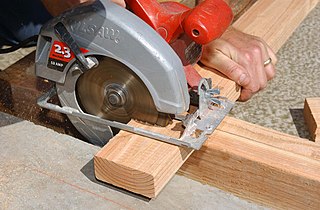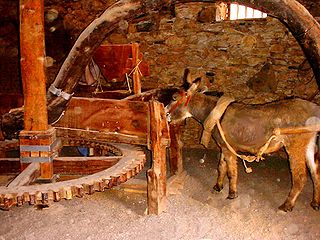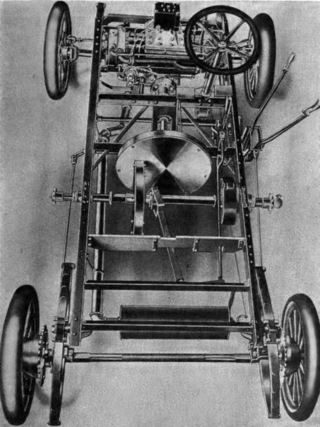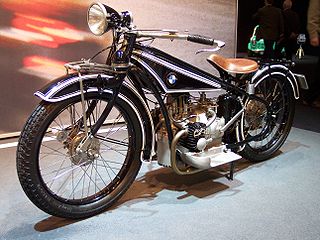Related Research Articles

A machine is a physical system using power to apply forces and control movement to perform an action. The term is commonly applied to artificial devices, such as those employing engines or motors, but also to natural biological macromolecules, such as molecular machines. Machines can be driven by animals and people, by natural forces such as wind and water, and by chemical, thermal, or electrical power, and include a system of mechanisms that shape the actuator input to achieve a specific application of output forces and movement. They can also include computers and sensors that monitor performance and plan movement, often called mechanical systems.

A circular saw is a power-saw using a toothed or abrasive disc or blade to cut different materials using a rotary motion spinning around an arbor. A hole saw and ring saw also use a rotary motion but are different from a circular saw. Circular saws may also be loosely used for the blade itself. Circular saws were invented in the late 18th century and were in common use in sawmills in the United States by the middle of the 19th century.

A power tool is a tool that is actuated by an additional power source and mechanism other than the solely manual labor used with hand tools. The most common types of power tools use electric motors. Internal combustion engines and compressed air are also commonly used. Tools directly driven by animal power are not generally considered power tools.

A sawmill or lumber mill is a facility where logs are cut into lumber. Modern sawmills use a motorized saw to cut logs lengthwise to make long pieces, and crosswise to length depending on standard or custom sizes. The "portable" sawmill is simple to operate. The log lies flat on a steel bed, and the motorized saw cuts the log horizontally along the length of the bed, by the operator manually pushing the saw. The most basic kind of sawmill consists of a chainsaw and a customized jig, with similar horizontal operation.

A drive shaft, driveshaft, driving shaft, tailshaft, propeller shaft, or Cardan shaft is a component for transmitting mechanical power and torque and rotation, usually used to connect other components of a drivetrain that cannot be connected directly because of distance or the need to allow for relative movement between them.

A linear actuator is an actuator that creates linear motion, in contrast to the circular motion of a conventional electric motor. Linear actuators are used in machine tools and industrial machinery, in computer peripherals such as disk drives and printers, in valves and dampers, and in many other places where linear motion is required. Hydraulic or pneumatic cylinders inherently produce linear motion. Many other mechanisms are used to generate linear motion from a rotating motor.

A line shaft is a power-driven rotating shaft for power transmission that was used extensively from the Industrial Revolution until the early 20th century. Prior to the widespread use of electric motors small enough to be connected directly to each piece of machinery, line shafting was used to distribute power from a large central power source to machinery throughout a workshop or an industrial complex. The central power source could be a water wheel, turbine, windmill, animal power or a steam engine. Power was distributed from the shaft to the machinery by a system of belts, pulleys and gears known as millwork.

A horse mill is a mill, sometimes used in conjunction with a watermill or windmill, that uses a horse engine as the power source. Any milling process can be powered in this way, but the most frequent use of animal power in horse mills was for grinding grain and pumping water. Other animal engines for powering mills are powered by dogs, donkeys, oxen or camels. Treadwheels are engines powered by humans.
A horse engine is a machine for using draft horses to power other machinery. It is a type of animal engine that was very common before internal combustion engines and electrification. A common design for the horse engine was a large treadmill on which one or more horses walked. The surface of the treadmill was made of wooden slats linked like a chain. Rotary motion from the treadmill was first passed to a planetary gear system, and then to a shaft or pulley that could be coupled to another machine. Such powers were called tread powers, railway powers, or endless-chain powers. Another common design was the horse wheel or sweep power, in which one or several horses walked in a circle, turning a shaft at the center. Mills driven by horse powers were called horse mills. Horse engines were often portable so that they could be attached to whichever implement they were needed for at the time. Others were built into horse-engine houses.

A friction drive or friction engine is a type of transmission that utilises two wheels in the transmission to transfer power from the engine to the driving wheels. The system is naturally a continuously variable transmission; by moving the two disks' positions, the output ratio changes continually. Although once used in early automobiles, today the system is most commonly used on scooters, mainly go-peds, in place of a chain and gear system. It is mechanically identical to a ball-and-disk integrator, but intended to handle higher torque levels.

A portable engine is an engine, either a steam engine or an internal combustion engine, that sits in one place while operating, but is portable and thus can be easily moved from one work site to another. Mounted on wheels or skids, it is either towed to the work site or moves there via self-propulsion.

The BMW R32 was the first motorcycle produced by BMW under the BMW name. An aircraft engine manufacturer during World War I, BMW was forced to diversify after the Treaty of Versailles banned the German air force and German aircraft manufacture. BMW initially turned to industrial engine design and manufacturing.

A chain is a serial assembly of connected pieces, called links, typically made of metal, with an overall character similar to that of a rope in that it is flexible and curved in compression but linear, rigid, and load-bearing in tension. A chain may consist of two or more links. Chains can be classified by their design, which can be dictated by their use:

The Fire Ball is a type of amusement ride manufactured by Larson International. It replaced a series of Larson rides manufactured prior to its unveiling, the first being the Super Loops and the second being the Ring of Fire. The ride features a roller coaster-type train which rolls along a ring-shaped track, turning riders upside down at the top of the loop. Older models of this ride type have trains with each half of the train facing opposite directions, with a protective metal cage and a rigid lap bar restraining the riders. In 1998, Larson introduced a new roofless, open-air train with over-the-shoulder harnesses and seats that sit riders face-to-face with each other. Some owners of the older Ring of Fire rides have had the caged train replaced with the new Fire Ball train.

This glossary of mill machinery covers the major pieces of machinery to be found in windmills, watermills and horse mills. It does not cover machinery found in modern factories.

A jackshaft, also called a countershaft, is a common mechanical design component used to transfer or synchronize rotational force in a machine. A jackshaft is often just a short stub with supporting bearings on the ends and two pulleys, gears, or cranks attached to it. In general, a jackshaft is any shaft that is used as an intermediary transmitting power from a driving shaft to a driven shaft.

A screw press is a type of machine press in which the ram is driven up and down by a screw. The screw shaft can be driven by a handle or a wheel. It works by using a coarse screw to convert the rotation of the handle or drive-wheel into a small downward movement of greater force. The overhead handle usually incorporates balls as flyweights. The weights helps to maintain the momentum and thrust of the tool to make it easier to operate.
Cummings Machine Works was a Boston, Massachusetts based business. It was founded by Henry Havelock Cummings in 1881, when Cummings was 23 years old. The company was awarded a United States Defense Department contract to manufacture fixtures in March 1941. The contract amounted to $17,893. The company was among the firms which contributed to the building of the Boston Opera House, completed in 1909, supplying steelworks used in the construction of the stage.

The accessory drive is a gearbox that forms part of a gas turbine engine. Although not part of the engine's core, it drives the accessories, fuel pumps, etc., that are otherwise essential for the operation of the engine or the aircraft on which it is mounted. Accessory drives on large engines handle between 400–500 hp.
A Rail Drilling Machine is a type of portable drilling machine specialized for drilling holes in rails. Rail Drilling Machines are also popularly called as Rail Drills, Portable Rail Drill, Rail Core Drilling Machines, etc.
References
- ↑ USpatent 2490255,Henry A. Chase,"Portable Power Actuated Rim-Driven Annular Saw", assigned to Cummings Machine Works
- ↑ US2490255A,Chase, Henry A.,"Portable power actuated rim-driven annular saw",issued 1949-12-06
- ↑ "Definition of SALLY SAW". www.merriam-webster.com. Retrieved 2023-08-07.